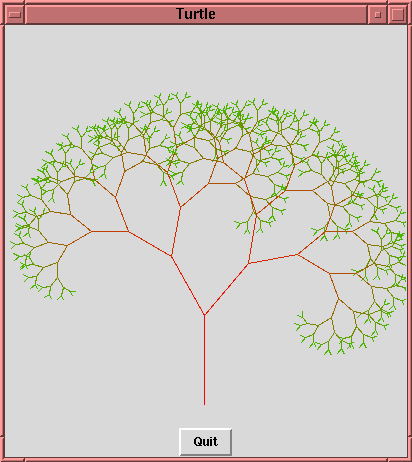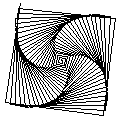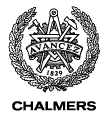Assignment 1
Description
This lab assignment asks you to implement a library for so-called
turtle
graphics. The library will be interfaced to as an
embedded
language. Several extensions are then made to the original turtle
language.
We recommend that you implement the graphics part of the lab either using
WxHaskell
or to generate SVG files. If you would like to use a different
graphics library please contact Jean-Philippe before starting the
assignment.
Turtle Graphics
The idea of turtle graphics was originally part of the Logo programming
language. It originated from an environment where a real robot (the "turtle")
could move around and act on simple commands. The two basic commands it
understood were:
forward n
right d
Here,
n is the number of steps the robot should move
forward, and
d the number of degrees the robot should
turn. More information can be found on the
Turtle
graphics wikipedia page (or in a local copy of the
"Logo primer").
The idea is that you will implement a part of this turtle graphics language.
Your program will be able to produce something like the following output:

Below follow a number of tasks. Needless to say, please read these
carefully and make sure you do not miss parts of an assignment! Most
assignments require coding and descriptions + motivations of
what you have done.
Part I
Deadline: Wed Jan 26
The first part of this assignment is just to get you started. You should
get started also on Part II before the deadline for Part I.
Part I - Task 1 - WxHaskell
Familiarise yourself with WxHaskell by writing a simple program which
opens a window and draws something in it.
Part I - Task 2 - Library interface
The turtle graphics language should be implemented as an embedded language
library in Haskell. The turtle language should be provided to the user as a
single module, exporting abstract datatypes and operations.
An important part of creating an embedded language is to think carefully
about what interface you want to offer to the user. Think about
compositionality (how easy is it to combine simpler programs to
build more complex ones?), and abstraction (hiding irrelevant
implementation details from the users).
For instance, your library might define and export the following things
(different interfaces are conceivable and perhaps even desirable, as long
as they implement the same basic functionality):
type Program -- the abstract type of a turtle program
forward :: Double -> Program
right :: Double -> Program
...
Other turtle commands you should provide are:
penup,
pendown, which stop drawing and start drawing respectively,
color, which changes the color of the turtle's pen,
stop,
which stops the execution of a program,
backward,
left, and
times (that repeats a turtle program a certain number of times),
and
forever that repeats a program forever. Also think in what
ways you would like to combine two turtle programs!
Write down the interface of your library, like in the example above,
listing the types you plan to export (without definitions) and type
signatures for the operations. When appropriate add explanations of what
your operations are intended to do. Make sure you don't forget to add
a run function for your programs.
Part I - Task 3 - Example
Write down the
spiral example from Logo language
using your interface. In their syntax it looks like:

spiral 0 91
|
to spiral :size :angle
if :size > 100 [stop]
forward :size
right :angle
spiral :size + 2 :angle
end
|
You won't be able to run your spiral example yet.
Part II
Deadline: Wed Feb 2
In this part of the assignment you will implement your turtle language and
add a few extensions.
Part II - Task 1 - Implementation
Implement the library you designed in Part I. Think about the distinction
between primitive operations and derived operations, and try to keep the
set of primitive operations as small as possible.
At this point you might realise that the interface you've designed is
missing some operations, or that parts of it are difficult to implement.
Don't hesitate to change the interface in these cases--just be clear that
you did change it and motivate why you felt a change was necessary.
Make sure that you carefully define the borders of your library by
explicitly exporting only the things you want a user to see (as given by
the interface you've designed).
Part II - Task 2 - Parallel composition
Add a
parallel composition combinator to your turtle language.
One possible interface parallel composition could have is:
(<|>) :: Program -> Program -> Program
When you run a turtle program
p <|> q, there suddenly will be two turtles, one
running
p and the other running
q, in parallel. Decisions you
have to make are: What happens after a parallel composition finishes? Is your
parallel composition commutative, is it associative? (To answer this question you
must first define what it means for programs to be equal.) Describe and motivate your
decisions!
Part II - Task 3 - Extensions
Several extensions to the simple turtle language can be made. Implement at
least one extension from this list:
- Add a save construct to the language:
save :: Program -> Program
The meaning of the program save p is to recall the
current position of the turtle and to continue with the program
as if nothing happened. But as soon as we are done, we return to
the saved state and execute the program p from that
point. When you have several save statements in your
program, all of them should be saved and later executed, but you
may decide yourself in what order.
- Add a pause construct to your language. In this case,
you will add a button with the text "Continue" to the graphical
interface. This button is normally inactive, but when the
turtle program executes the pause command, it halts, and
the "Continue" button becomes active. When the user clicks on
the "Continue" button, the program continues and the continue
button becomes inactive again.
You can use other methods to wait for the user
(keyboard); but make sure to make clear in the report.
- Similar to (2), but instead of an explicit pause, you have a combinator
called stepping.
stepping :: Program -> Program
The meaning of the program stepping p is: execute
p as normal, but the user is required to click the
"Continue" button at every step during the execution of
p.
- Add the commands showturtle and hideturtle to
your language, which toggle between having a turtle picture
shown when drawing the pictures or not. A variant of this
allows different turtle bitmaps and maybe even a background
image. One can then describe simple animations. Also see the
section "Up and Away" from the above mentioned "Logo primer".
- Add a way to your language of finding out information about for
example, where the turtle currently is, where the mouse pointer
is, or if the user clicks the mouse. It should be
possible to then use this information in your turtle programs.
- Invent your own extension to the turtle language. By extension
I mean something that cannot be implemented in terms of the
existing language constructs. (But be creative, we may judge
your extension to be too easy!)
Part II - Task 4 - Examples
Implement some examples that together use all of the constructs you have
implemented. (Do this in a different module that imports the module
defining the embedded language.) Also indicate your "favorite" turtle
program, resulting in a cool picture or animation. I will publish these
somewhere on the course homepage.
Part II - Task 5 - Thoughts and reflections
Answer the following questions:
- Did you use a shallow or a deep embedding, or a combination?
Why? Discuss in a detailed manner how you would have implemented
the Program type if you had chosen the other approach. What
would have been easier/more difficult?
- What changes did you have to make to your program to implement
the extensions? Do you think you could have avoided some of
these by having chosen a different library design from the
start?
- Compare the usability of your embedding against a custom-made
implementation of a turtle language with dedicated syntax and
interpreters. How easy is it to write programs in your embedded
language compared to a dedicated language? What are the
advantages and disadvantages of your embedding?
- Compare the ease of implementation of your embedding against a
custom-made implementation. How easy was it to implement the
language and extensions in your embedded language compared to a
dedicated language? What are the advantages/disadvantages of
your embedding?
- In what way have you used the following programming language
features: higher-order functions, laziness, polymorphism?
Submission
Deadline
The deadline for the first part is Wed Jan 26 and the deadline for
the second part is Wed Feb 2. The final deadline is Wed Mar 16. (Please read
the rules
on what first and final deadline mean.) Both parts of the assignment should
be submitted in the same place, under
Assignment 1 in the
reporting system.
Clean Code
Before you submit your code, Clean It Up! Submitting clean code is Really
Important, and simply the polite thing to do. After you feel you are done, spend
some time on cleaning your code; make it simpler, remove unneccessary things,
etc. We will reject your solution if it is not clean. Clean code:
- Does not have long lines (< 80 characters)
- Has a consistent layout
- Has type signatures for all top-level functions
- Has good comments
- Has no junk (junk is unused code, commented code, unnecessary comments)
- Has no overly complicated function definitions
- Does not contain any repetitive code (copy-and-paste programming)
Submission
Your submission needs to include the following information:
- Your Haskell files (.hs or .lhs), containing your
solution. There should at least be one file called Turtle.hs, providing
the interface to your turtle language, and a file called Examples.hs,
providing the examples. Do not submit .o, .hi or .exe files!
- report.txt or report.pdf, a file containing documentation
of what you have done: For each module, describe what is in the module and
why it is in that module. Also give the motivations you were asked to give in
the assignments, answers to questions, and how to use your language.
Before you submit,
please read the note on cheating.
You are supposed to submit your solution using the Fire system.
Note: You do NOT have to use zip/gzip/tar/bzip on
your files! Just upload and each file that is part of your
solution. Don't forget to submit when you have uploaded all the files.
To the Fire System
Good luck!




 Printable version
Printable version